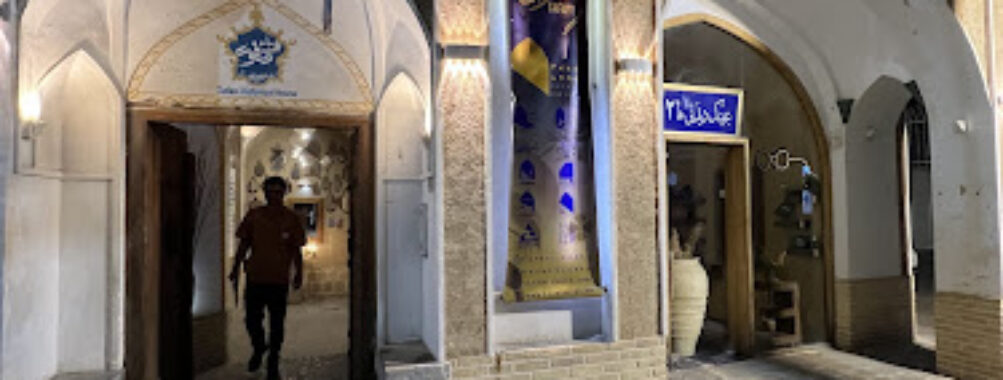
Safavi House
“`html
Table of Contents
Description
Safavi House is one of those places that quietly pulls you in and makes you want to linger a little longer than you planned. Tucked away in the heart of Isfahan, this historic art café feels like a time capsule with a modern heartbeat. The building itself dates back centuries, echoing the architectural grace of the Safavid era—arched doorways, intricate plasterwork, and those classic wooden windows that filter sunlight just right. When you step inside, you can almost feel the stories of generations who’ve passed through here, sipping tea and sharing laughter long before Wi-Fi was a thing.
What makes Safavi House stand out isn’t just its history—it’s the atmosphere. There’s this easy blend of old and new: antique furniture paired with local artwork, Persian calligraphy on the walls, and the faint aroma of freshly ground coffee mingling with the scent of rosewater desserts. It’s the kind of café where you can sit alone with your laptop for hours or chat endlessly with friends over saffron tea and pistachio cake. And honestly, the desserts here? They might just ruin you for any other café in town.
The place has a cozy, lived-in charm. It’s not fancy in a showy way—it’s comfortable, welcoming, and real. The staff are warm without being intrusive, and there’s this unspoken understanding that you’re allowed to take your time. Whether you’re a traveler exploring Isfahan’s historic core or a local looking for a quiet corner to unwind, Safavi House just fits. It’s a perfect little pause in the middle of a city that’s always humming with life.
Key Features
- Beautifully preserved Safavid-era architecture with traditional Iranian design elements
- Outdoor seating area ideal for enjoying Isfahan’s mild evenings
- Excellent coffee, tea, and dessert selection—especially the Persian sweets
- Casual yet historic atmosphere, blending art, culture, and comfort
- Popular spot for breakfast, brunch, and dinner with a full dining menu
- Perfect for solo travelers, groups, and digital nomads working on laptops
- Romantic and cozy ambiance, often favored by couples and art enthusiasts
- Child-friendly environment with a relaxed vibe
- Accepts credit and debit cards for convenience
- Reservations recommended for dinner hours
Best Time to Visit
If you ask me, Safavi House is one of those places that feels different depending on the time of day—and that’s part of its charm. Morning visits are peaceful, filled with the smell of freshly brewed coffee and soft chatter. It’s perfect if you like to start your day slow, maybe with a Persian breakfast and a bit of journaling. By midday, the café buzzes with life—locals dropping in for lunch, travelers comparing notes on nearby attractions, and the occasional artist sketching quietly in the corner.
Evenings are something else entirely. The lighting turns warm and golden, the air cools down, and the courtyard feels almost magical. If you’re visiting between March and May or again in late September through November, you’ll catch Isfahan at its most pleasant—sunny days, crisp nights, and just the right weather for outdoor seating. Summer afternoons can get hot, so it’s better to visit later in the day when the heat eases. Winter has its own quiet charm, though; sipping hot saffron tea while wrapped in a shawl feels almost poetic.
How to Get There
Getting to Safavi House is fairly straightforward if you’re exploring central Isfahan. Most travelers either walk from nearby attractions or hop in a local taxi. The streets leading to it are narrow and full of character—lined with small shops selling handicrafts, spices, and textiles. If you’re staying in one of the traditional guesthouses or boutique hotels nearby, it’s likely just a short stroll away.
Public transportation options include buses and ride-hailing apps, which are reliable and affordable. That said, walking is honestly the best way to experience this part of the city. You’ll stumble upon hidden courtyards, art galleries, and maybe even a street musician or two along the way. Just remember that parking can be tricky, and the area isn’t the most wheelchair-friendly due to uneven cobblestone paths and narrow entrances typical of historical buildings.
Tips for Visiting
Here’s the thing about Safavi House—it rewards those who take their time. Don’t rush your visit; order a tea, find a seat by the window, and just watch life unfold around you. If you’re into photography, bring your camera because the light here is incredible—especially in the late afternoon when it filters through those old wooden windows.
If you’re planning to come for dinner, it’s smart to make a reservation since it can get busy. The café is especially popular among students and tourists, so peak hours can be lively. And while the menu leans toward local flavors, there are also lighter bites and international options if you’re craving variety.
One more thing—don’t skip dessert. Seriously. The cakes and pastries are not just sweet treats; they’re little works of art. I still remember the first time I tried their rosewater cake—it was so delicate and fragrant that I ended up ordering another slice just to make sure it was real.
If you’re traveling with kids, you’ll find the place welcoming and safe, though it’s more suited for quiet family time than playtime. And if you’re a remote worker or digital nomad, bring your laptop. The vibe is calm enough for work, and the coffee keeps flowing.
In short, Safavi House isn’t just a café—it’s an experience. It’s where history meets hospitality, where every cup of tea feels like a small celebration of Isfahan’s artistic soul. Whether you come for a quick bite or stay for hours, you’ll leave with the feeling that you’ve touched a small piece of Iran’s living history—and that’s something worth remembering.
“`
Location
Places to Stay Near Safavi House
Find and Book a Tour
Explore More Travel Guides
No reviews found! Be the first to review!